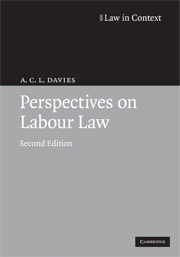Book contents
- Frontmatter
- Contents
- Preface
- Acknowledgements
- Table of statutes
- Table of statutory instruments
- Table of EU legislation
- Table of international instruments
- Table of cases
- Abbreviations
- PART I
- PART II
- 5 Who is protected by employment law?
- 6 Working time
- 7 Discrimination
- 8 Wages
- 9 Dismissal
- 10 Collective representation
- 11 Trade union membership
- 12 Industrial action
- What next?
- Index
5 - Who is protected by employment law?
Published online by Cambridge University Press: 28 January 2010
- Frontmatter
- Contents
- Preface
- Acknowledgements
- Table of statutes
- Table of statutory instruments
- Table of EU legislation
- Table of international instruments
- Table of cases
- Abbreviations
- PART I
- PART II
- 5 Who is protected by employment law?
- 6 Working time
- 7 Discrimination
- 8 Wages
- 9 Dismissal
- 10 Collective representation
- 11 Trade union membership
- 12 Industrial action
- What next?
- Index
Summary
This chapter will be an important testing-ground for your views on the various theoretical positions we have explored so far. Its topic is: who is protected by employment law? You might expect that the whole workforce would be protected, but in fact this is not the case. The law divides people up into three groups – employees, workers and the self-employed – and offers them different levels of protection. Employees are the traditional subjects of employment law, so they get all the available rights. Self-employed people are thought to be capable of looking after themselves, so with a few exceptions they are not given any rights at all. This twofold classification has come to seem problematic in recent years because of the rising number of so-called ‘atypical workers’: people who do not fit within the law's definition of an employee but do not seem to be genuinely self-employed either. Since 1997, some legislation has used a third concept – ‘worker’ – to include these people. Workers do not have as many rights as employees, but they are better protected than the self-employed.
From a neoclassical economics perspective, labour rights are viewed as a burden on business. If an employer is obliged by the law to confer rights on workers, it will compensate for this increase in its costs either by cutting those workers' wages or by making some of them redundant. The employer will also be reluctant to create new jobs.
- Type
- Chapter
- Information
- Perspectives on Labour Law , pp. 77 - 96Publisher: Cambridge University PressPrint publication year: 2009



